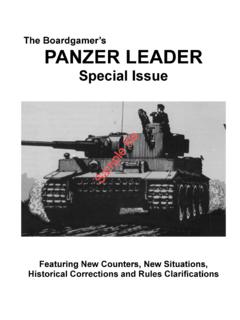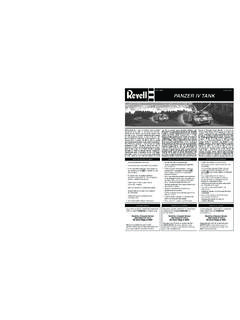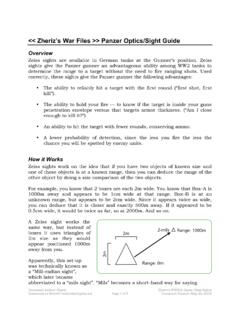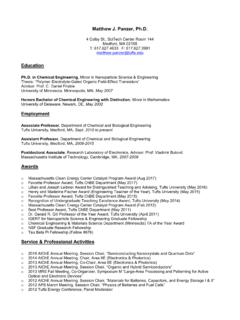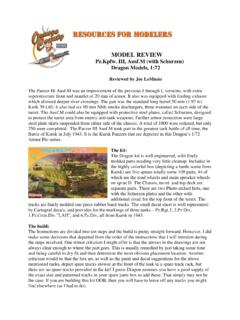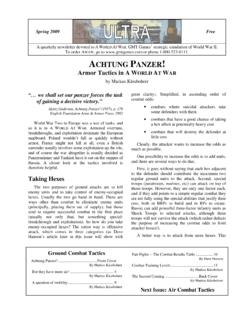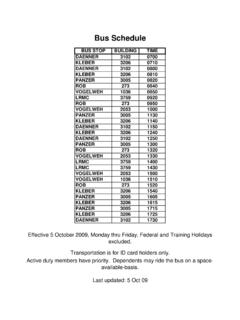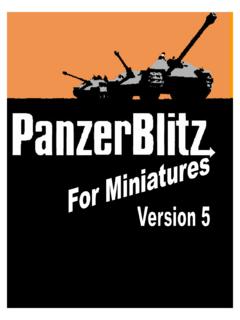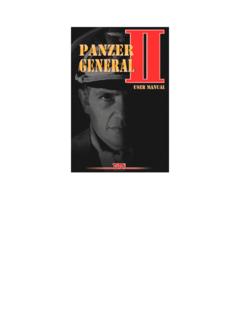Transcription of RULES OF PLAY - Imaginative Strategist
1 RULES OF play I. INTRODUCTION panzer LEADER is a realistic game simulating tactical level combat on the Western Front during World War Two. The twenty game situations cover the gamut of combat encounters between the Allies and their German adversaries. Additionally, the open-ended design of the panzer LEADER game system allows players to design and compile their own situations, thus creating unlimited game possibilities. Like its famous sister-game, PANZERBLITZ (Tactical Armored Combat on the Eastern Front, 1941-45), panzer LEADER is not only an exciting game experience; it is also a valuable source of comparative information illustrating the strengths and weaknesses of the opposing German, British and American armies.
2 IF YOU HAVE NEVERED PLAYED A WARGAME BEFORE, don t be overwhelmed by what may look like a lot of complicated RULES . Sometimes more than a few words are required to precisely express a simple and easily understood concept. REMEMBER: These RULES are based on common sense applications of real-life events and operations. As such, their only purpose is to translate real-world occurrences into the game format. It is not necessary to memorize these RULES . Read the RULES once, play a practice game or two, and then re-read any sections that are unclear, bearing in mind the experience gained in the practice games.
3 Once the basics of movement and combat are understood, the finer points of the RULES will fall into place as you gain experience. A WORD TO VETERAN AVALON HILL GAME PLAYERS: Although this game is based on the familiar PANZERBLITZ game-system, many subtle refinements and changes have been added. Read ALL of the RULES before beginning play , as even some of the standard RULES sections contain significant changes. II. COMPONENTS A. GAME EQUIPMENT 1. Mapboard Mapboard consisting of four sections which can be joined together in a variety of ways to form many different terrain configurations.
4 2. German Counters German die-cut counter sheet (192 pieces). 3. Allied Counters Allied die-cut counter sheet (192 pieces). 4. Cards Set of Situation and Player Aid Cards (seven cards). 5. RULES RULES of play and Designer s Notes booklet. 6. One Die B. THE MAPBOARD The four-section mapboard represents a varied sampling of typical terrain in France and Germany. Each section is identified by a letter (A,B, C, or D) located just above the fold line. The board is geomorphic capable of being changed by re-arranging the four sections in a variety of juxtapositions.
5 The long edge of each mapboard section will line up with the long edge of any other section no matter which way they are joined together, except for the sea edge of board B . The short edges join with each other in a similar fashion. The scale of the mapboard is 1 hexagon = 250 meters. Refer to the Terrain Effects Chart for a complete explanation of mapboard symbols and their effects on movement and combat. C. THE PLAYING PIECES The die-cut, cardboard pieces represent platoon or battery-sized military units of different types ( , infantry platoons, tank platoons, assault gun platoons, etc.)
6 , which are the playing pieces used in the game. Hereafter they will be referred to as units or unit counters . The numbers on the unit counters represent that unit s capabilities with respect to movement, attack, defense and range of weapons. The other symbols or silhouettes identify what type of units the counters represent. Note that all vehicle units are symbolized with an appropriate silhouette and all other (non-vehicle) units are symbolized with standard military-planning symbols. Movement Allowance: The basic maximum number of hexagons (hexes) which a unit may move in one turn, expressed as a certain number of movement points.
7 In general each unit will expend one movement point from its movement (point) allowance to move a distance of one hex. Attack Strength: The basic offensive power of a given unit, expressed as a certain number of attack strength points. ATTACK STRENGTH WEAPONS TYPE RANGE SYMBOL TYPE OF UNIT DEFENSE STRENGTH MOVEMENT ALLOWANCE PICS NUMBER Defense Strength: The basic defensive strength of a given unit, expressed as a certain number of defensive strength points. Range: The maximum effective distance (in hexes) that a unit s attack strength can be used against enemy units.
8 EXAMPLE: a unit with a range of 8 could fire its weapons (use its attack strength) against an enemy unit s defensive strength within that 8-hex range. III. GENERAL OUTLINE OF play Each side maneuvers its forces (playing pieces) on the terrain map seeking to destroy enemy units or gain a specific territorial objective as outlined on the Situation Cards. Players move their pieces and have combat by taking turns. Each complete turn represents six minutes of real time. The forces in a given Situation may be unequal and one side may have a better chance of winning than the other, but it is primarily the skill of the individual player which determines the outcome of the game.
9 The chance element introduced by the use of the die-roll Combat Results Table is only that degree of chance consistently present in any real-life combat event. IV. SEQUENCE OF TURNS panzer LEADER is played in turns. Each turn is divided into two identical player segments: the Allied player segment and the German player segment. To avoid confusion, each player segment is further divided into four phases . A. ALLIED PLAYER SEGMENT 1. Combat Phase Allied player executes and resolves minefield attacks, direct and indirect fire combat, and writes orders for the next turn s indirect fire combat.
10 2. Air Phase Allied player moves any aircraft units desired. German player executes and resolves anti-aircraft attacks. Allied player resolves fighter bomber attacks. 3. Movement Phase Allied player moves any units that did not fire in the combat phase. 4. Close Assault Phase Allied player executes and resolves all CAT attacks. B. GERMAN PLAYER SEGMENT German player follows the same procedure as outlined above using his own units. C. TURN NOW The Turn Now counter is moved one box signifying the completion of one game turn. This procedure is followed for each turn of the game.
